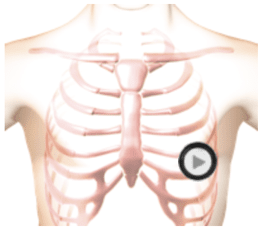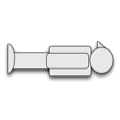Second Heart Sound and Late Systolic Click
Virtual Auscultation


The patient's position is supine.
Lesson
Certain heart sound configurations mimic a split second heart sound. One of these conditions is a late systolic click plus a single second heart sound (S2). Since the late systolic click occurs just before the S2, it is easy to confuse the two with a split S2. Listen carefully to the two sounds. If the first of the pair is of higher frequency and shorter duration than the second, it is a late systolic click followed by a single second heart sound. Another way of distinguishing a late systolic click from a split S2 is to move the stethoscope head to the pulmonic area. The late systolic click will disappear, and you will only hear the single S2. A late systolic click is caused by degeneration of the mitral valve leaflets. This degeneration causes the closing of the leaflets to make a "clicking" sound during late systole. On the anatomy video you will see prolapse of the anterior lateral mitral valve leaflet which is the cause of the late systolic click.Waveform
Heart Sounds Video
Authors and Sources
Authors and Reviewers
-
Heart sounds by Dr. Jonathan Keroes, MD and David Lieberman, Developer, Virtual Cardiac Patient.
- Lung sounds by Diane Wrigley, PA
- Respiratory cases: William French
-
David Lieberman, Audio Engineering
-
Heart sounds mentorship by W. Proctor Harvey, MD
- Special thanks for the medical mentorship of Dr. Raymond Murphy
- Reviewed by Dr. Barbara Erickson, PhD, RN, CCRN.
-
Last Update: 12/11/2022
Sources
-
Heart and Lung Sounds Reference Library
Diane S. Wrigley
Publisher: PESI -
Impact Patient Care: Key Physical Assessment Strategies and the Underlying Pathophysiology
Diane S Wrigley & Rosale Lobo - Practical Clinical Skills: Lung Sounds
- Essential Lung Sounds
Diane S. Wrigley, PA-C
Published by MedEdu LLC - PESI Faculty - Diane S Wrigley
-
Case Profiles in Respiratory Care 3rd Ed, 2019
William A.French
Published by Delmar Cengage - Essential Lung Sounds
by William A. French
Published by Cengage Learning, 2011 - Understanding Lung Sounds
Steven Lehrer, MD
- Clinical Heart Disease
W Proctor Harvey, MD
Clinical Heart Disease
Laennec Publishing; 1st edition (January 1, 2009)